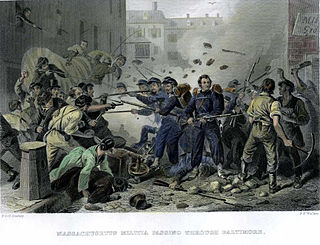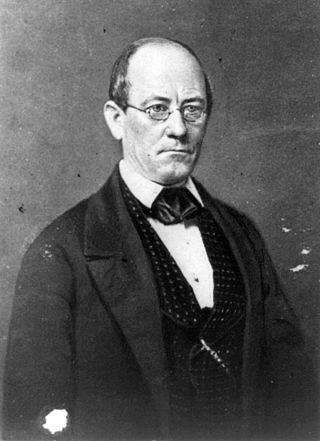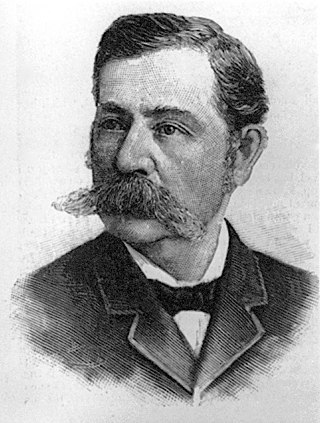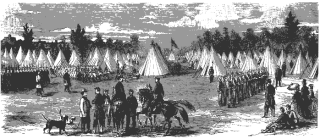Related Research Articles

Fort Sumter is a sea fort built on an artificial island near Charleston, South Carolina to defend the region from a naval invasion. It was built after British forces captured and occupied Washington during the War of 1812 via a naval attack. The fort was still incomplete in 1861 when the Battle of Fort Sumter occurred, sparking the American Civil War. It was severely damaged during the battle and left in ruins. Although there were some efforts at reconstruction after the war, the fort as conceived was never completed. Since the middle of the 20th century, Fort Sumter has been open to the public as part of the Fort Sumter and Fort Moultrie National Historical Park, operated by the National Park Service.

The First Battle of Bull Run, called the Battle of First Manassas by Confederate forces, was the first major battle of the American Civil War. The battle was fought on July 21, 1861, in Prince William County, Virginia, just north of the city of Manassas and about thirty miles west-southwest of Washington, D.C. The Union Army was slow in positioning themselves, allowing Confederate reinforcements time to arrive by rail. Each side had about 18,000 poorly trained and poorly led troops. The battle was a Confederate victory and was followed by a disorganized post-battle retreat of the Union forces.

The Battle of Fort Sumter was the bombardment of Fort Sumter near Charleston, South Carolina by the South Carolina militia. It ended with the surrender by the United States Army, beginning the American Civil War.

The Confederate Army of the Potomac, whose name was short-lived, was under the command of Brig. Gen. P. G. T. Beauregard in the early days of the American Civil War. Its only major combat action was the First Battle of Bull Run. Afterwards, the Army of the Shenandoah was merged into the Army of the Potomac with Gen. Joseph E. Johnston, the commander of the Shenandoah, taking command. The Army of the Potomac was renamed the Army of Northern Virginia on March 14, 1862, with Beauregard's original army eventually becoming the First Corps, Army of Northern Virginia.

The Baltimore riot of 1861 was a civil conflict on Friday, April 19, 1861, on Pratt Street, in Baltimore, Maryland. It occurred between antiwar "Copperhead" Democrats and other Southern/Confederate sympathizers on one side, and on the other, members of Massachusetts and Pennsylvania state militia regiments en route to the national capital at Washington who had been called up for federal service. The fighting began at the President Street Station, spreading throughout President Street and subsequently to Howard Street, where it ended at the Camden Street Station. The riot produced the first deaths of Union volunteers by hostile action, although caused by civilians, in the American Civil War. Civilians among the attackers also were killed.

The Battle of Blackburn's Ford took place on July 18, 1861, in the Confederate state of Virginia, as part of the Manassas campaign of the American Civil War. Union general Irvin McDowell's Army of Northeastern Virginia was marching south towards the Confederate capital of Richmond, and encountered the Confederate Army of the Potomac under the command of P. G. T. Beauregard. McDowell sent troops from Daniel Tyler's division to probe the Confederate defenses along Bull Run Creek to locate the Confederate left flank. At Blackburn's Ford, the Union troops attempted to cross but Confederate fire broke up the attack. The repulse at Blackburn's Ford led McDowell to seek to attack the Confederates at a different point along their line, leading to the First Battle of Bull Run three days later.

John Letcher was an American lawyer, journalist, and politician. He served as a Representative in the United States Congress, was the 34th Governor of Virginia during the American Civil War, and later served in the Virginia General Assembly. He was also active on the Board of Visitors of Virginia Military Institute.

Robert Cumming Schenck was a Union Army general in the American Civil War, and American diplomatic representative to Brazil and the United Kingdom. He was at both battles of Bull Run and took part in Jackson's Valley Campaign of 1862, and the Battle of Cross Keys. He served two separate multi-term stints in the U.S. House of Representatives.

The Army of the Shenandoah was a field army of the Confederate States Army active during the American Civil War. It was created to defend the Shenandoah Valley of Virginia from Union Army attacks during the early months of the war. The army was transferred to reinforce the Confederate Army of the Potomac at the First Battle of Bull Run, which was the only major engagement of the war it participated in. After the battle, the army was merged into the Army of the Potomac.

Theodore Runyon was a United States politician, diplomat, and American Civil War brigadier general in the New Jersey Militia, serving with the Union Army at the Battle of First Bull Run. Runyon was a lawyer before the Civil War and mayor of Newark, New Jersey, a major general in command of the New Jersey National Guard until 1873, first president of the Manufacturers' National Bank of Newark, chancellor of New Jersey for 14 years and, between 1893 and 1896, envoy and later ambassador to Germany.

The 11th New York Infantry Regiment was an infantry regiment of the Union Army in the early years of the American Civil War. The regiment was organized in New York City in May 1861 as a Zouave regiment, known for its unusual dress and drill style, by Colonel Elmer E. Ellsworth, a personal friend of U.S. President Abraham Lincoln. Drawn from the ranks of the city's many volunteer fire companies, the unit was known alternately as the Ellsworth Zouaves, First Fire Zouaves, First Regiment New York Zouaves, and U.S. National Guards.
Thornsbury Bailey Brown of Taylor County, Virginia is generally considered the first Union soldier killed by a Confederate soldier during the American Civil War. Brown, a member of a Virginia militia or volunteer company which supported the Union with the grade of private, was killed by a member of a Virginia militia or volunteer company which supported the Confederacy at Fetterman, Virginia on May 22, 1861. The members of both companies were from the same general vicinity of Taylor County.

The Battle of Fairfax Court House was the first land engagement of the American Civil War with fatal casualties. On June 1, 1861, a Union scouting party clashed with the local militia in the village of Fairfax, Virginia, resulting in the first deaths in action, and the first wounding of a field-grade officer.
The Battle of Arlington Mills, Virginia, was one of the first military engagements of the American Civil War, a week after the Union occupation of that part of Virginia opposite Washington, D.C. It occurred on June 1, 1861, at about 11:00 p.m., a few hours after the Battle of Fairfax Court House.

The Manassas campaign was a series of military engagements in the Eastern Theater of the American Civil War.

James Cameron was a Pennsylvanian who served as colonel of the 79th New York Volunteer Infantry Regiment of the Union Army during the early days of the American Civil War. He was the brother of Simon Cameron, United States Senator and first United States Secretary of War in the cabinet of President Abraham Lincoln. At the age of 61, James Cameron was killed in action at the First Battle of Bull Run, the first large battle of the war, on July 21, 1861.

Luther Crawford Ladd was a soldier in the Union Army who was killed during the Baltimore riot of 1861. He is often referred to as the first Union soldier killed in action during the American Civil War. Luther Crawford Ladd was 17 years old at the time of his death.

John Lane Gardner (1793–1869) served in the U.S. Army eventually achieving the rank of brevet Brigadier General after serving in the American Civil War having also served in the War of 1812, the Second Seminole War and the Mexican–American War. After Gardner retired from military service he devoted time to recruiting for the Army.

The 5th Regiment Massachusetts Volunteer Militia was a peacetime infantry regiment that was activated for federal service in the Union army for three separate tours during the American Civil War. In the years immediately preceding the war and during its first term of service, the regiment consisted primarily of companies from Essex County as well as Boston and Charlestown.

The 6th Regiment Massachusetts Volunteer Militia was a peacetime infantry regiment that was activated for federal service in the Union army for three separate terms during the American Civil War (1861-1865). The regiment gained notoriety as the first unit in the Union Army to suffer fatal casualties in action during the Civil War in the Baltimore Riot and the first militia unit to arrive in Washington D.C., in response to President Abraham Lincoln's initial call for 75,000 troops. Private Luther C. Ladd of the 6th Massachusetts is often referred to as the first Union soldier killed in action during the war.
References
- ↑ Hurd, Duane Hamilton Jr. (1888). "History of Essex County, Massachusetts, Volume 1". Philadelphia: J.W. Lewis & Company, 1888. Retrieved 24 November 2018.
- ↑ Detzer, David. Dissonance: The Turbulent Days Between Fort Sumter and Bull Run. New York: Harcourt, 2006. ISBN 978-0-15-603064-9. p. 119: "Corporal Needham, a plasterer from Lawrence...was shot in the neck, then smashed by the crowd and kicked to a pulp. He lingered in Baltimore for eight days before dying of his wounds."
- ↑ Detzer, David. Dissonance: The Turbulent Days Between Fort Sumter and Bull Run. New York: Harcourt, 2006. ISBN 978-0-15-603064-9. p. 119: "The first to die was Private Luther C. Ladd, born in New Hampshire on his father's farm."
- ↑ Kimball, Charles A. (June 1, 1861). ""Luther C. Ladd...The First Victim of the War"". Harpers Weekly. p. 341. Retrieved June 13, 2017. The article in this edition of Harper's Weekly is dated May 16, 1861.